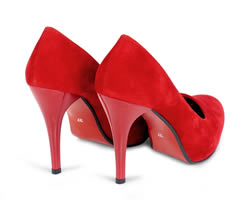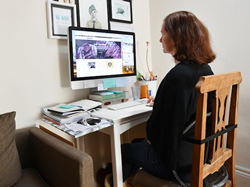Michele Weldon* says there is debate over the necessity for women to wear high heels in the workplace to signify arriving at a position of leadership.
 If you believed Carrie Bradshaw in Sex and The City, it was all about the Manolo Blahniks.
If you believed Carrie Bradshaw in Sex and The City, it was all about the Manolo Blahniks.
They were the key to her appeal, her power, her femininity.
Fast forward to now.
If you believe Summer Brennan, author of the new book High Heel, then teetering high heels are the symbol of power in the workplace for women — and have been connected to female identity for centuries.
Where do you stand on the shoe debate in the workplace?
Brennan writes in The Guardian, “For better or worse, the high heel is now womankind’s most public footwear.”
“It is a shoe for events, display, performance, authority and urbanity.”
“In some settings and on some occasions, usually the most formal, it is even required.”
“High heels are something like neckties for women, in that it can be harder to look both formal and femme without them.”
“Women have been compelled by their employers to wear high-heeled shoes in order to attend work and work-related functions across the career spectrum.”
I am a shoe lover and admit with great pride that early in my career I was a market editor for Footwear News.
I do think shoes can make a grand personal statement, but I have never been one to teeter in super high heels for a full work day.
Because they hurt.
While high heels at work are a personal choice in most countries, in Japan, women are mandated to wear high heels, which has prompted a nationwide protest.
“To protest against this form of discrimination, women have launched an online movement called ‘#KuToo’,” according to The Quint.
“The #KuToo movement takes a leaf out of the #MeToo movement as women finally speak out about the pain of having to work with heels.”
“A lot of people are drawing parallels between having to wear heels at work with the discriminatory tradition of ‘foot binding’,” The Quint reports.
Citing unsafe working conditions, in 2018 the Philippines banned “companies from forcing female employees to wear high heels at work, in a move lauded by a labour union which said it was one of the first countries in the world to do so to protect women’s rights”, according to Reuters.
In the UK, Parliament received a petition with 150,000 signatures asking to revise the dress code at some organisations, requiring women to wear high heels at work.
“Women at work who feel pressure to prove they deserve to be in the room might be wary of ditching their blazers and pumps,” write Jena McGregor and Taylor Telford in The Washington Post.
“We know that appearance matters for women and people of colour in being seen as competent and worthy of respect,” Jaclyn Wong, a Professor of Sociology at the University of South Carolina, told the Post.
“It becomes this difficult position: ‘Do I want to dress down because I don’t want to be seen as this kind of stiff and un-fun person, or do I want to continue dressing up because that’s the only way people will treat me with respect?’”
The talk over the necessity to wear high heels in the workplace to signify arriving to a position of leadership, is not just a generational issue or an affordability issue, but a comfort issue.
Kela Walker, US TV host and producer, told ABC News: “There is something about a great heel that empowers me as a woman.”
“Heels change your whole posture, you stand up straight, walk proud and feel empowered in a way that a flat simply can never do.”
But ask a woman in any industry what footwear she prefers to wear to work and some insist high heels are done in the C-suite.
Abha Bhattarai writes in The Washington Post, “Women are trading in their high-heeled stilettos for sneakers and ballet flats.”
“But analysts say there are other changes afoot, too: more people are working from home, and those who do go into the office are more often walking to work.”
Brennan adds, “The dominant narratives in society and media still struggle to see women as individuals.”
“Public feminist intellectuals are routinely castigated for criticising individual women with whom they disagree, even when that disagreement has not been expressed in a gendered or sexist manner.”
“It comes up a lot when women fight about whether or not they should wear high heels.”
The history of high heels is that it was not gender specific until about 200 years ago; before that both men and women wore high heels.
Elizabeth Semmelhack, Senior Curator at the Bata Shoe Museum in Toronto, tells Quartz: “High heels — less practical than flat-heeled shoes for anyone not on horseback — soon became associated with supposedly female traits of frivolity and irrationality.”
“By the 19th century, in Europe, the heel was ‘unassailably feminine’.”
“Once European men abandoned the heel in the early 18th century, the meaning becomes so hyper feminised that as imperialism goes global, those are the meanings that are brought with the high heel.”
Semmelhack adds, “Heels are just things. They can be given any meaning we decide they have.”
Gloria Feldt, co-founder and president of Take The Lead, writes that her favourite book as a child was The Wizard Of Oz, in which Dorothy’s red shoes are key to the narrative.
Feldt writes, “Dorothy was so afraid of the wicked witch that she didn’t realise the slippers she wore had more power than the witch.”
“‘You’ve always had the power’, Glinda, the good witch tells Dorothy at the end of her journey.”
“When Dorothy asks why Glinda didn’t tell her that before, Glinda replies that Dorothy wouldn’t have believed her — she had to find out for herself.”
She adds, “And like Dorothy, women today [are on a] quest for self-determination, equality, parity, personhood, respect, and what I call the Power To.”
“We are challenged to pull back the curtain on broken political systems and dysfunctional workplaces and create a new power paradigm.”
And we can do that in whatever shoes we see fit — high heels or not.
* Michele Weldon is Editorial Director of Take The Lead and a senior leader with The OpEd Project. She tweets at @micheleweldon and her website is www.micheleweldon.com.
This article first appeared at www.taketheleadwomen.com.











